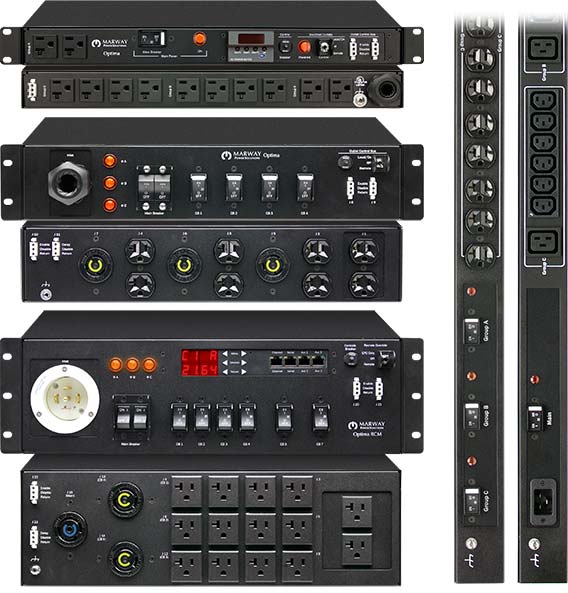Optima™ PDUs by Voltage
Product SelectorPDUs by Voltage Rating ↑
Marway’s standard Optima 5 series basic PDUs, and Optima 8 series smart PDUs are available in the following voltages.
Additionally, we design and manufacture custom PDUs for European mains and other applications up to 600 volts. We may be able to find a suitable pre-designed system to match to your needs from our semi-standard units, or we can create a new PDU to meet your unique needs.
Understand PDU Voltage Ratings ↑
- 240 volts = standard U.S. single phase
(the LN of a facility 415 Vac 3Φ wye) - 120 volts = standard U.S. single phase
(the LN of a facility 208 Vac 3Φ wye) - 120/208 volts = standard U.S. three phase wye
Power delivered to U.S. industrial and commercial facilities will usually include 208 three-phase wye (as either the main power, or as a secondary source off a larger primary source). Different power configurations may be present depending on the original intent of the building, or a need to power specialty equipment.
With the conventional 120/208 Vac facility power, there are three main power lines (a.k.a. phases) along with a neutral and ground. The voltage between any two of the main lines (L-L) is 208 volts. The voltage between any one main line and neutral (L-N) is 120 volts. Marway’s standard PDUs are designed for their main power source to be either 120 Vac (which uses L-N), 200-240 Vac (which uses L-L), or the full 120/208 Vac 5-wire connection.
Which voltage should I choose? ↑
Generally, you will already have a known set of equipment to be powered. The needs of this equipment will dictate what the PDU should provide.
If all your equipment is powered by 120 Vac, there’s no reason to not choose a PDU with same input source. Select a current capacity suitable to meet the load when all the equipment is on (we have 15 Amp, 20 Amp, and 30 Amp capacities), and a model with enough outlets, and you’re set.
Choosing a 200-240 Vac PDU, which will commonly have C13 outlets (or NEMA 6-15 or 6-20), is usually reserved for when you have a specialized electronic equipment set designed to use the higher voltage. Or, all of your equipment may be compatible with a 100-240 Vac range. Running it all at 240 Vac will pull fewer amps than running it at 120 Vac. This may be something a facility designer has expected to do in specific work areas to help improve efficiency, or lower the electrical facility costs (there are savings from using smaller gauge wiring).
Opting for a 3-phase-powered PDU will be reserved for when you have a mixture of 120 Vac and 200-240 Vac equipment, or your equipment actually needs three-phase power itself.
Therefore, the choice of which voltage to use, for the most part, comes down to simply picking the one which is compatible with the equipment which needs to be powered.
